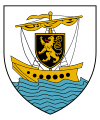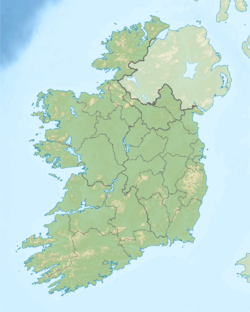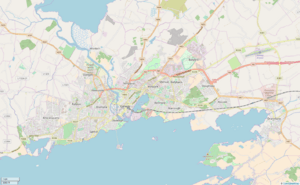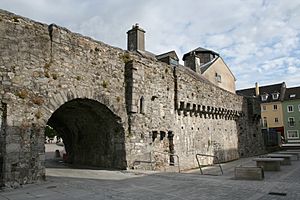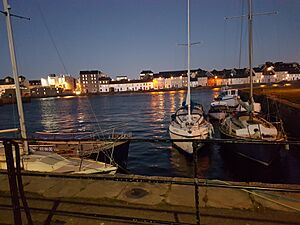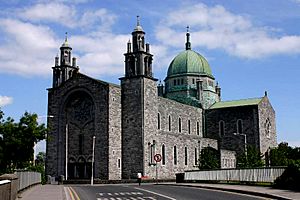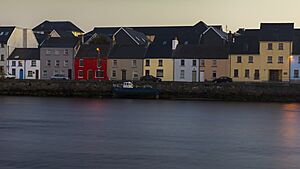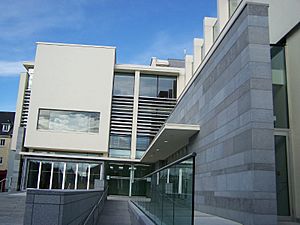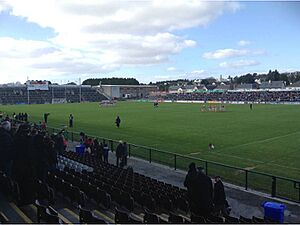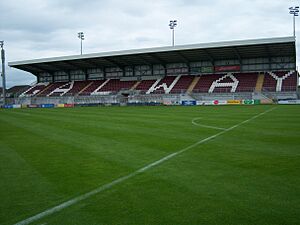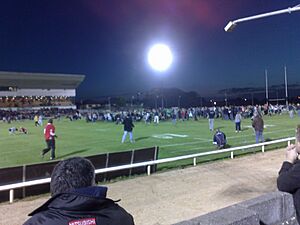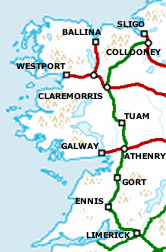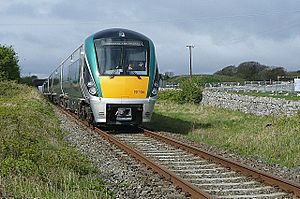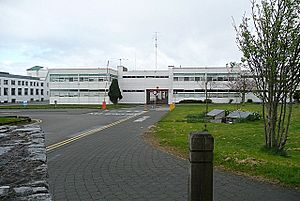Galway facts for kids
Quick facts for kids
Galway
Gaillimh
|
||
|---|---|---|
|
City
|
||
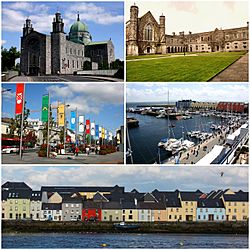
From top; left to right: Galway Cathedral, University of Galway, Eyre Square, Galway Harbour, the Long Walk
|
||
|
||
| Nickname(s):
"City of the Tribes"
|
||
| Motto(s): | ||
| Country | Ireland | |
| Province | Connacht | |
| Region | Northern and Western (West) | |
| County | Galway | |
| Founded | 1124 AD | |
| City Rights | 1484 & 1985 AD | |
| Area | ||
| • Total | 57.3 km2 (22.1 sq mi) | |
| Elevation | 25 m (82 ft) | |
| Population
(2022)
|
||
| • Total | 85,910 | |
| • Rank | 4th | |
| • Density | 1,499.3/km2 (3,883/sq mi) | |
| Demonyms | Galwegian, Tribesman | |
| Time zone | UTC0 (WET) | |
| • Summer (DST) | UTC+1 (IST) | |
| Eircode (Routing Key) |
H91
|
|
| Area code(s) | 091(+353 91) | |
| Vehicle Index Mark Code |
G | |
Galway is a lively city in County Galway, Ireland. It sits where the River Corrib meets Galway Bay. It is the biggest city in the province of Connacht. Galway is also the fourth largest city in the Republic of Ireland. In 2022, about 85,910 people lived there.
Galway grew around a fort built in 1124. In 1484, the city gained special rights to govern itself. It became a busy trading port, controlled by powerful merchant families known as the Tribes of Galway. Today, Galway is a popular place for tourists. It is famous for its many festivals and events, like the Galway International Arts Festival. In 2020, Galway was even named a European Capital of Culture.
Contents
What's in a Name?
The name Galway comes from the Irish word Gaillimh. This was the name of the river that formed the western edge of the first settlement. The old fort was called Dún Gaillimhe, meaning "Fort Gaillimh". In Latin, the city's name is Galvia. People from Galway are called Galwegians.
Galway is also known as the "City of the Tribes." This nickname comes from the fourteen merchant families who ruled the city long ago. They were called the "Tribes of Galway."
A Look Back in Time
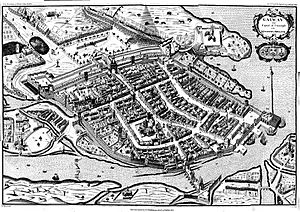
Galway started as a fort called Dún Gaillimhe. It was built in 1124 by the King of Connacht. This fort was a naval base for his ships. A town soon grew up around it. In the 1230s, a Norman leader named Richard Mor de Burgh took over the fort.
Over time, the Norman families in Galway became more like the Irish. The city's merchants, known as the Tribes of Galway, wanted more control. In 1484, the English king gave them the right to have their own mayor. Galway had some tough rules back then. A sign on the city gate warned, "From the Ferocious O'Flahertys may God protect us." Also, native Irish people were not allowed to walk freely in the city without permission.
During the Middle Ages, Galway was run by fourteen merchant families. They were known as the "Tribes of Galway." The city became a very important port for trade with Spain and France. A famous old part of the city wall, now called the Spanish Arch, was built during this time. In 1477, the explorer Christopher Columbus even visited Galway!
In the 1600s, Galway sided with the Catholic Irish during a war. As a result, Cromwell's forces captured the city after a long siege. Later, in 1691, the city was taken again by Williamite forces. These events caused the powerful Galway families to lose their wealth. The city also suffered greatly during the Great Famine in the mid-1800s.
Galway's Weather and Places to See
Galway's Climate
Galway has a mild, wet, and changeable climate. This is because of the winds from the North Atlantic Current and the Gulf Stream. Temperatures rarely go below freezing or above 30°C (86°F). The city gets about 1156 mm (45 inches) of rain each year. January is usually the coolest month, and July is the warmest.
Sometimes, strong storms from the Atlantic hit Galway. These usually happen between late autumn and early spring. In summer, Galway has long daylight hours. The sun rises early and sets late. In winter, the days are much shorter.
Cool Places to Explore
Galway has many interesting places to visit:
- Lynch's Castle on Shop Street is a medieval building from the 1500s. It was built by the wealthy Lynch family and is now a bank.
- St. Nicholas' Collegiate Church was founded in 1320. It is the largest medieval church in Ireland that is still used every day.
- Galway Cathedral was finished in 1965. It has a mix of old and new styles, with a large dome and round arches.
- The University of Galway has a beautiful old building from 1849. The university keeps a special collection of spoken Celtic languages for UNESCO.
- The Hardiman Hotel (originally the Railway Hotel) was built in 1845. It is Galway's oldest hotel still open today.
- The ruins of Menlo Castle are outside the city. It was once home to the Blake family, one of the "Tribes of Galway."
- The Eglinton Canal connects the River Corrib to the sea. It is just over a kilometer long.
- The Claddagh is the oldest part of Galway. It was once a village of fishing folk. The famous Claddagh Ring comes from this area.
- The Browne doorway is now in Eyre Square. It was once the entrance to the Browne family's townhouse.
- The Lynch Window on Market Street tells a famous legend. It is said that in 1493, Mayor James Lynch FitzStephen had his own son executed for murder.
- The Hall of the Red Earl is an old medieval building from the 1200s. It was used for collecting taxes and holding court.
The Claddagh Neighborhood
On the west side of the River Corrib is the old neighborhood of The Claddagh. For many years, people here spoke Irish. The Claddagh was mainly a fishing village. It was led by an elected "King" who helped solve problems. The last King died in 1972, but the title is still used for special events. This area is also famous for the Claddagh Ring.
Museums to Visit
The Galway City Museum has two main parts. One is about Galway's history, and the other shows art by Irish artists. It is located near the Spanish Arch.
The University of Galway also has museums. These include the James Mitchell Geology Museum and the Computing and Communications Museum of Ireland.
The Nora Barnacle House Museum is the smallest museum in Ireland. Nora Barnacle was the wife of the famous writer James Joyce.
Cemeteries
Fort Hill Cemetery is the oldest cemetery still used in Galway City. It has a memorial to over 300 sailors from the Spanish Armada who were buried there in the 1580s.
Rahoon Cemetery offers nice views of the city. Many famous people are buried here, including those who inspired characters in James Joyce's stories.
Bohermore Cemetery is another large cemetery. It is the burial place of writers like Pádraic Ó Conaire and Lady Gregory. There is also a memorial for those who died in a plane crash off the coast in 1958.
Who Lives in Galway?
In 2022, Galway city had a population of 85,910 people. This was a big increase from 2011. Most people living in Galway are Irish. However, about 20% of the population are from other countries. Many come from European countries like Poland, Latvia, and Lithuania. There are also people from Asia and Africa.
Galway's Culture and Fun

Galway is known as Ireland's Cultural Heart. It hosts many festivals and events. In 2014, UNESCO named Galway a City of Film.
In 2008, a survey said Galway was the 42nd best tourist spot in the world. It was ranked 14th in Europe and second in Ireland, after Dingle.
Arts and Creativity
Literature
Galway is home to many poets and writers. Famous Irish writers like Liam O'Flaherty and Pádraic Ó Conaire have connections to Galway. The University of Galway has special collections of old writings and documents.
Galway also has literary magazines like The Galway Review. Charlie Byrne's Bookshop is a popular place for book lovers.
Film
Galway has several movie theaters. In 2014, Galway became a Unesco "City of Film."
The city hosts the Galway Film Fleadh every July. This is Ireland's most important film festival. It shows films from all over the world and supports Irish movies. In 2014, it was named one of the "25 Coolest Film Festivals in the World."
Theatre
Galway has an Irish language theatre called Taibhdhearc na Gaillimhe. It opened in 1928. The Druid Theatre Company from Galway is famous worldwide for its plays.
Other theatres in the city include Nuns Island Theatre and the Town Hall Theatre. Many famous Irish actors, like Siobhán McKenna and Peter O'Toole, have strong ties to Galway.
Music Scene
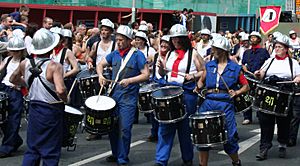
Galway has a lively music scene. You can hear traditional Irish music in pubs and from street performers. The Galway Early Music Festival features old European music.
The Galway Arts Festival happens every July. It is one of Ireland's biggest arts festivals. It brings in artists from around the world and showcases local talent. The festival includes parades, street shows, plays, concerts, and comedy.
Traditional Irish Music
Galway city is a major hub for traditional Irish music. Famous traditional groups like De Dannan started here. Many well-known musicians are from Galway or became famous there.
Groups like Comhaltas teach traditional Irish music to children. Dusty Banjos offers classes for adults who want to learn.
Popular and Live Music
You can find live music in many places around the city. Some popular spots include The Crane Bar and Róisín Dubh.
Galway is mentioned in several songs. These include "Galway Girl" by Steve Earle and "Galway Girl" by Ed Sheeran.
Irish Language and Traditions
Galway City is known for its connection to the Irish language. It is sometimes called the "Bilingual Capital of Ireland." Many people speak English, but Irish culture is very strong here. The city is close to the Galway Gaeltacht, where Irish is the main language.
Irish theatre, TV, and radio are important parts of Galway life. An Taibhdhearc is the National Irish Language Theatre in the city. The TV station TG4 and radio station RTÉ Raidió na Gaeltachta are based nearby.
Events and Festivals
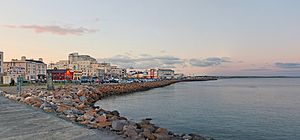
Galway hosts many events throughout the year. The biggest ones are the Galway Film Fleadh and the Galway Arts Festival in July. Then come the Galway Races in August and the Galway International Oyster Festival in September.
Other fun events include the Baboró International Children's Festival, the Cúirt International Festival of Literature, and the Galway Comedy Festival. There is also the Galway Christmas Market and the Galway Pride Festival.
Religion
The patron saint of Galway since the 1300s is St Nicholas of Myra. The main Catholic church is Galway Cathedral. The Church of Ireland also has a strong presence, with St. Nicholas' Collegiate Church being a very old and important church. Other Christian groups and the Ahmadiyya mosque also have places of worship in the city.
Sports in Galway
Galway has a rich sports history. Popular sports include horse racing, Gaelic games, soccer, rugby, and rowing. The Galway Races are famous worldwide and last for seven days.
Gaelic Games
Both hurling and football are very popular in Galway. Pearse Stadium in Salthill is the home ground for Galway GAA teams. The Galway hurlers compete for the Liam MacCarthy Cup. They won it in 2017 for the first time in 29 years. The Gaelic footballers compete for the Sam Maguire Cup. They have won it nine times, most recently in 2001.
Soccer
Galway United FC is the city's soccer team. They play in the League of Ireland Premier Division at Eamonn Deacy Park. The current club started in 2013.
Rugby
The professional rugby team for the province, Connacht Rugby, is based in Galway. They play their home games at the Galway Sportsgrounds. In 2016, Connacht Rugby won their first ever Pro14 Championship!
There are also amateur rugby clubs in Galway, like Galwegians RFC and Galway Corinthians RFC.
Swimming and Water Sports
Salthill has a 25-meter swimming pool at the Leisureland complex. Three swimming clubs train there.
Rowing is popular on the River Corrib. Seven rowing clubs use the river and organize competitions. In 2009 and 2012, Galway hosted a stopover for the Volvo Ocean Race, a round-the-world sailing competition.
Greyhound Racing
The Galway Sportsgrounds also hosts greyhound races on Thursday, Friday, and Saturday nights.
Galway's Economy and Transport
Galway City is the main city in Connacht. It has a strong economy with many different types of businesses. These include manufacturing, tourism, retail, education, and healthcare.
Many people in Galway work in business or professional jobs. A lot also work in manufacturing, especially in hi-tech areas like medical equipment and electronics. Big companies like Boston Scientific and Medtronic have offices here. Tourism is also very important. In 2000, over 2.1 million visitors came to Galway.
Media
Radio
Galway has two radio stations. Galway Bay FM broadcasts to the whole county. Flirt FM is the student radio station for the University of Galway.
The Connacht Tribune is a regional newspaper printed twice a week. The Galway Advertiser is a free paper printed every Thursday.
Getting Around Galway
Air Travel
Galway Airport no longer has regular passenger flights. The runway is too short for modern planes. Aerfort na Minna, west of the city, has flights to the Aran Islands. The closest international airports are Shannon Airport and Ireland West Airport.
Buses
Buses are the main way to get around Galway. Bus Éireann and City Direct operate routes within the city. Other companies provide buses to places across County Galway and Ireland. The main bus station is Ceannt Station.
Trains
Galway's main train station is Ceannt Station. It opened in 1851. Trains run daily between Galway and Dublin Heuston. The journey takes just under 3 hours. Trains also connect Galway to Ennis and Limerick. From Limerick, you can get trains to Cork and other southern cities.
Roads
Four main national roads serve Galway. The M6 motorway goes east to Dublin. The M17 goes north to Tuam. The N63 (formerly N17) connects to the Northwest. The M18 motorway links Galway to southern cities like Limerick and Cork.
Galway is also the starting point for exploring Connemara and the Gaeltacht areas.
Waterways
The River Corrib is very important to Galway. Many canals were built to control the river's water. These canals helped power early industries in the 1800s. The Eglinton Canal allows boats to travel from the sea to the river.
Today, there are four bridges over the Corrib River. There are plans for a fifth bridge as part of a new bypass project.
Harbour
Galway has a central port on the West Coast of Ireland. It is in the sheltered Galway Bay. The harbour can handle large ships.
Regular ferries travel between Galway and the Aran Islands, a popular tourist spot. The islands are home to the World Heritage Site Dún Aonghasa.
Walking
Galway is the planned start of the E2 European long-distance path. This path runs for 4850 km (3013 miles) all the way to Nice, France.
Education in Galway
Schools
In 2002, Galway had 27 primary schools and 11 secondary schools.
Universities
Galway has two university campuses. These are the University of Galway and the Atlantic Technological University.
The University of Galway was founded in 1845. It was renamed "Ollscoil na Gaillimhe – University of Galway" in 2022. It has many different colleges, including Arts, Medicine, Business, Science, and Engineering. Over 16,000 students attended in 2010.
The Atlantic Technological University (ATU) was created in 2022. It combined the Galway Mayo Institute of Technology (GMIT) with two other institutes. Its main office is in Galway. The Galway campus has schools for Business, Engineering, Science & Computing, and Tourism & Arts.
The Central Applications Office (CAO), which handles college applications in Ireland, is also based in Galway.
Famous People from Galway
Many notable people have connections to Galway. These include writers, musicians, actors, and sports figures.
See also
 In Spanish: Galway para niños
In Spanish: Galway para niños


